There are 16 different types of frogs in New Jersey, some of which are subspecies. Many of the frog’s species can be found all across the state, but some will have a limited range.
Freshwater sources are used by various species to breed and some frogs prefer to stay near water. Most will live near water, but frogs and toads can be found on land, in trees, or even buried underground.
New Jersey is the fifth-smallest state, but still, has plenty of frog species to enjoy. In this article, you will find all of the frog species in the state and descriptions about each one.
Frogs are found in a variety of habitats, sometimes living in residential areas. Areas with a healthy population of native frog and toad species are usually a sign of a healthy habitat.
Identifying a species can be done by its location, features, and the sounds they make. Using this list you will be able to learn about different species for the next time you find yourself in nature or come across a frog.
Table of Contents
Here are all 16 frogs that can be found in New Jersey:
Frogs In New Jersey
1. Eastern Spadefoot

- Experience Level: Beginner
- Family: Scaphiopodidae
- Scientific Name: Scaphiopus holbrookii
- Other Names: The spadefoot toad
- Adult Size: 1.75 to 2.25 inches
- Lifespan: 2 to 10 years
- Average Price Range: $10 to $20
Eastern Spadefoots are a species that can be found in the Southern half of New Jersey. Areas with sandy soils are preferred by this species since they are burrowing species.
Temporary sources of water are used by this frog to breed, which happens during heavy rain. They spend most of their life underground, only coming out to hunt and breed. They are active from spring to fall, becoming inactive during the winter.
This species is small with gray, brown, or black coloring. They have large yellow eyes with horizontal pupils. Their skin is smooth with no warts and they have pale yellow bellies.
Eastern spadefoots are named after the black spade on the back of their foot, which is used for digging. The call this species makes when breeding is a quick, nasally grunt.
Eastern spadefoots survive on a variety of insects and small invertebrates. They will generally hunt at night and can survive for a few days off of one feeding. Birds, fish, and snakes are common predators of this species.
They do not secrete any toxins and rely on their secretive nature to defend themselves. This species has a healthy population, and on rare occasions will even resort to cannibalism when hungry.
2. American Toad

- Experience Level: Beginner
- Family: Bufonidae
- Scientific Name: Anaxyrus americanus
- Other Names: Eastern American toad
- Adult Size: 2 to 3.5 inches
- Lifespan: 2 to 10 years
- Average Price Range: $20 to $30
American Toads have a range in New Jersey, but only inhabit the Northern half of the state. Forests, woodlands, fields, and even residential areas are places this toad lives in. Sandy soil and plenty of ground litter are preferred by the American toad so they can bury themselves and take shelter. In their habitat, they will live near a shallow body of water so they can breed. At the beginning of the year, breeding occurs and will last till summer. Males will call for a mate, and make a high-pitched sound lasting for several seconds.
American toads are medium-sized, gray, reddish to brown, and have warty skin. They might also have black blotches covering their back, with one or two warts in them.
Their bellies are white, with a mottled pattern. Their eyes are dark with a parotoid gland behind them. Down the middle of some toads is a light-colored stripe.
Toxins from this toad’s skin help ward off predators from eating them, but predators are resistant to their toxin. American toads will try to camouflage or make themselves larger when threatened.
Snakes, birds, and mammals are this species’ main enemies.
American toads will feed on insects like ants, moths, and worms. They will hunt at night and spend their day buried underground.
3. Fowler’s Toad

- Experience Level: Beginner
- Family: Bufonidae
- Scientific Name: Anaxyrus fowleri
- Other Names: Bufo fowleri
- Adult Size: 2 to 3 inches
- Lifespan: 2 to 10 years
- Average Price Range: $10 to $20
The Fowler’s toad is found all across New Jersey. Open woodlands, sandy prairies, beaches, and meadows are areas where they will most likely be found.
In times of extreme hot or cold temperatures, they will spend the majority of their time underground. They are most active during the breeding season, which takes place in August after heavy rain.
Lakes, marshes, and rain pools are where they breed and lay their eggs. Thousands of eggs are laid at a time, which look long and stringy.
This species is medium-sized and can be brown, green, or gray. They are covered in dark spots with a light line that runs down the center of their back.
Males are darker than females. This species has warts within its blotch.
The eyes are dark, and parotoid glands are on their neck. Their bellies are lightly colored and spotted.
Fowler’s toad has a variety of predators like snakes, birds, and small mammals.s They are nocturnal and rely on camouflage to defend themselves.
They are also able to secrete a toxin from their skin when threatened that can poison predators. Small invertebrates and insects are what make up their diet.
4. Northern Cricket Frog

- Experience Level: Beginner
- Family: Hylidae
- Scientific Name: Acris crepitans
- Other Names: N/A
- Adult Size: 0.75 to 1.5 inches
- Lifespan: 5 to 10 years
- Average Price Range: $10 to $20
Northern Cricket frogs can be found all throughout New Jersey, living near slow-moving permanent waters. Found near the edges of streams, they will sometimes cluster together living in groups.
They are active during the day and most of the year. In winter when the extreme cold comes they will hibernate and bury themselves in the mud.
These frogs are one of the smallest species in North America, only reaching 1.5 inches at the most. They can be green, gray, or brown and have a dark blotch pattern on their back.
Their skin looks moist and is covered in warts. They have dark bands running down their legs, and a Y mark blotch on their head.
Insects, mostly mosquitos are what this species survives off of. Birds, fish, and other frogs will often prey on this species.
They have seen recent population declines like other frog species due to pollution and habitat loss. Still, they have a healthy population and are listed as a species of least concern.
5. Pine Barrens Treefrog
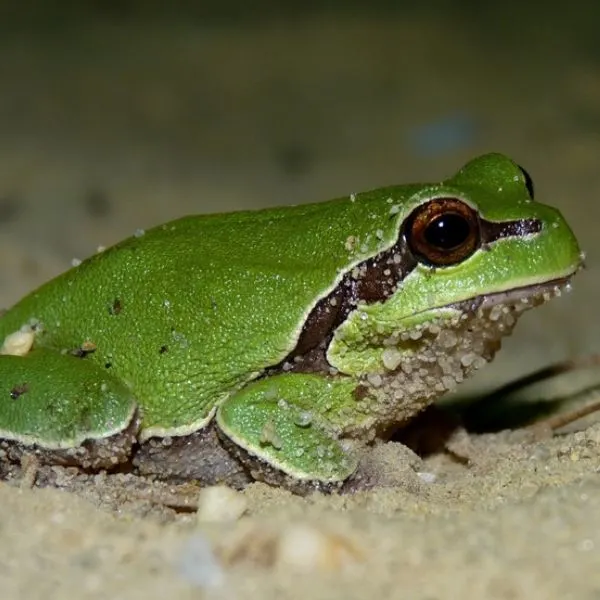
- Experience Level: Advanced
- Family: Hylidae
- Scientific Name: Dryophytes andersonii
- Other Names: N/A
- Adult Size: 1 to 1.75 inches
- Lifespan: 2 to 5 years
- Average Price Range: N/A
The pine barren tree frog lives in the southern half of New Jersey and needs a highly acidic habitat. Swamps, pine lowlands, bogs, rivers, and streams are some of the areas they can be found. Shallow water is needed, as well as water with a low pH value.
They will breed from May up until July. After breeding adults will go into pine forests and spend their time high in the trees.
This frog is bright green with a purple stripe running from its eye to leg on each side of its body. The purple coloring is surrounded by a white stripe.
Their feet are orange as well as their hind legs. On their stomach is a white bright coloring.
Their throats are a purple color. Pine barren tree frogs have big eyes shaded orange.
Grasshoppers, crickets, spiders, ants, and other small invertebrates are what this frog eats.
Predators like birds will try to eat this species, but the loss in habitat threatens that species more than anything. Water Ph changing and pollution causes this species to lose valuable breeding areas.
6. Gray Treefrog
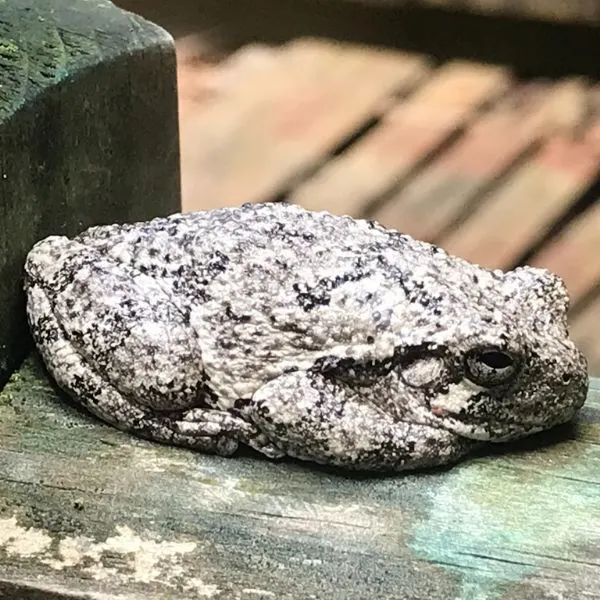
- Experience Level: Beginner to Intermediate
- Family: Hylidae
- Scientific Name: Dryophytes versicolor
- Other Names: Northern Gray Treefrog
- Adult Size: 1.25 to 2 inches
- Lifespan: 7 to 9 years
- Average Price Range: $20
The gray treefrog lives all over the state of New Jersey. Forests, woodlands, and swamps are areas where they normally live. They are nocturnal and will spend most of their time high in the trees.
From May through July they will breed and can be found near the edges of the water. Warm weather and heavy rain will usually trigger breeding. In winter they will hibernate and take shelter in trees.
Gray tree frogs are usually gray but can change their hue to match their surroundings. They have a mottled pattern with dark blotches and are covered in small warts.
Their pattern helps them blend into tree bark. Their inner legs have bright orange coloring.
Gray tree frogs are the first of two gray tree frog species in New Jersey. They are very similar to Cope’s Gray Treefrog but have a slower mating call.
Being nocturnal they will hunt for insects that come out at night. Spiders, plant lice, and snails are some options they have when hunting.
Spending most of their time in trees they are able to avoid common predators that feed on frogs. They also use their camouflage and color-changing to help defend themselves.
7. Cope’s Gray Treefrog

- Experience Level: Beginner to Intermediate
- Family: Hylidae
- Scientific Name: Dryophytes chrysoscelis
- Other Names: Southern Gray Treefrog
- Adult Size: 1.25 to 2 inches
- Lifespan: 10 to 15 years
- Average Price Range: $20
Cope’s Gray treefrog is the second gray tree frog species found in New Jersey and is only found in the Cape May, Atlantic, Cumberland, and Ocean counties in the state.
Ponds, swamps, and other temporary habitats are used for breeding in early spring. After breeding is complete they will move to forests and hardwood areas to spend time in the treetops.
They are active at night, and during winter they will hibernate in tree holes. They are able to survive freezing due to the natural antifreeze they produce.
This frog is gray, brown, or green, and has the ability to change its color to match the current conditions. They have orange on the inside of their thighs and a white belly.
Their body is mottled and covered in warts. Large toe pads sit on their feet to help them with climbing. Cope’s Gray treefrog is like the gray tree frog but has a higher-pitched and faster mating call.
Flying insects like mosquitoes and flies are what they usually eat, but will also feed on other insects. Habitat loss by pollution and dumping affects this species’ breeding ground.
The eggs of this treefrog are also preyed on by fish and adults are preyed on by larger animals. In the U.S they are listed as least concerned but are considered a threatened species in New Jersey.
8. Northern Spring Peeper
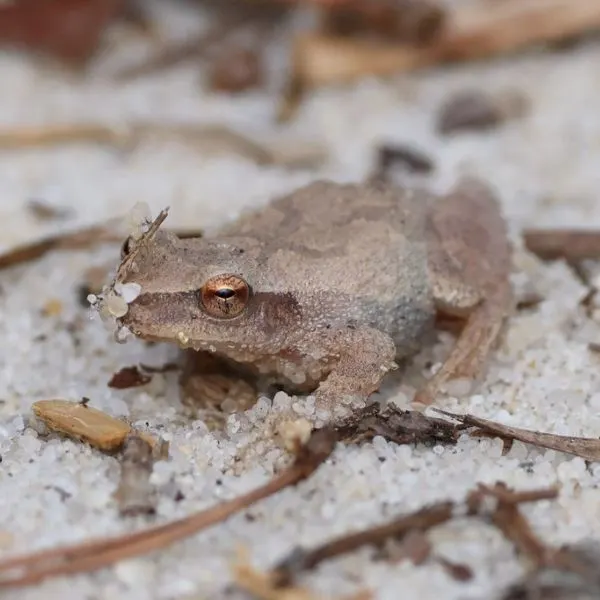
- Experience Level: Intermediate
- Family: Hylidae
- Scientific Name: Pseudacris crucifer
- Other Names: Spring peeper
- Adult Size: 0.75 to 1.25 inches
- Lifespan: 2 to 4 years
- Average Price Range: $10 to $20
The Northern spring peeper can be found in New Jersey and is abundant throughout the state. This treefrog can be found in marshes, swamps, and wet woodland habitats.
They are known for being one of the first frog species to emerge after hibernation, making a very loud mating call in late February. This species will spend most of its time on the ground, but are great climbers and can be found in trees.
Northern Spring Peepers have smooth skin, with gray, tan, or brown coloring. Their bellies are light white or yellow. They have an X-shaped mark on their back with dark coloring around their legs.
Their coloring is used to blend into tree bark and help them camouflage. They are also able to change their color to help them blend into their environment.
Spring peepers are nocturnal and use the time they are awake to hunt. Ants, beetles, and other small invertebrates are what they feed on.
This species has a healthy population in the State of New Jersey and can be heard once spring is on its way. This small species is also a popular pet and can be obtained in the wild or at a pet store.
9. Upland Chorus Frog

- Experience Level: Intermediate
- Family: Hylidae
- Scientific Name: Pseudacris feriarum
- Other Names: N/A
- Adult Size: 0.75 to 1.375 inches
- Lifespan: 1 to 5 years
- Average Price Range: N/A
The Upland chorus frog is a species found in the Northern half of New Jersey. Sussex, Warren, Hunterdon, Morris, Bergen, and Somerset are some of the New Jersey counties they live in. This species is identical to the New Jersey Chorus frog and is only different with its range and mating call.
Woodlands, swamps, marshes, and bogs are some of the habitats this species lives in. They are active year-round but are most active from November to March.
The upland chorus frog is brown, reddish, or olive-gray in color. They have rough bumpy skin, with dark spots on their back.
There is a white cream striped on their upper lip, and stripes running down their side. This species is small in size and has the ability to change its shade.
Spiders, ants, beetles, mosquitoes, and other small invertebrates make up a majority of their diet.
They have a healthy population and are listed as a species of least concern. Larger frogs, snakes, and birds often rely on this species as a source of food.
10. New Jersey Chorus Frog

- Experience Level: Intermediate
- Family: Hylidae
- Scientific Name: Pseudacris Kalmi
- Other Names: N/A
- Adult Size: 0.75 to 1.5 inches
- Lifespan: 1 to 5 years
- Average Price Range: N/A
Found all over New Jersey, the New Jersey chorus frog is commonly found in moist habitats. Floodplains, wet woodlands, marshes, swamps, and vernal pools are habitats this species is often found in.
Breeding occurs in winter until June, and eggs will be laid in shallow waters like marshes or ponds. Waters with high vegetation are needed since they lay their eggs attached to aquatic vegetation underwater.
Brown, gray or reddish is the New Jersey Chorus frogs coloring. They have blotch-like stripes running down their back that are dark brown. The feet are small with minimal webbing.
Dark lines run down their eyes stretching out their legs. The New Jersey Chorus frog has the same look as the upland chorus frog but can be told apart by its croak and location.
Insects and small invertebrates are what this species feeds on.
They are eaten by birds and snakes, but pollution in their habitat is the biggest threat. Even though they can be found throughout New Jersey, their population has been on a steady decline.
11. American Bullfrog

- Experience Level: Intermediate to Advanced
- Family: Ranidae
- Scientific Name: Lithobates catesbeianus
- Other Names: lithobates catesbeianus
- Adult Size: 3.5 to 8 inches
- Lifespan: 7 to 15 years
- Average Price Range: $20
American Bullfrogs are a common species found all over New Jersey, only missing from highly acidic waters. Bullfrogs are species that live in a wide variety of habitats like lakes, ponds, canals, creeks, and man-made water sources.
They will breed in permanent water sources and have the capability of laying a large number of eggs. Bullfrogs are a dominant frog species due to their size and aggressiveness.
They are a mixture of green and brown, olive green or gray colored. Their bellies are white with blotches on them.
Bullfrogs have large limbs, and their legs are often eaten by humans as a delicacy. Males are smaller than females.
On the side of their head is a large eardrum with yellow coloring. Bullfrogs are the largest frog in North America, giants compared to most species.
Their large size gives them the ability to eat and hunt a variety of prey. Birds, snakes, bats, other frogs, insects, and fish are some of the things they eat.
They are cannibalistic and will eat their kind. Bullfrogs are named after the sound they make, which sounds like a bull. They have three different calls; to mate, threaten, and signal combat.
12. Carpenter Frog
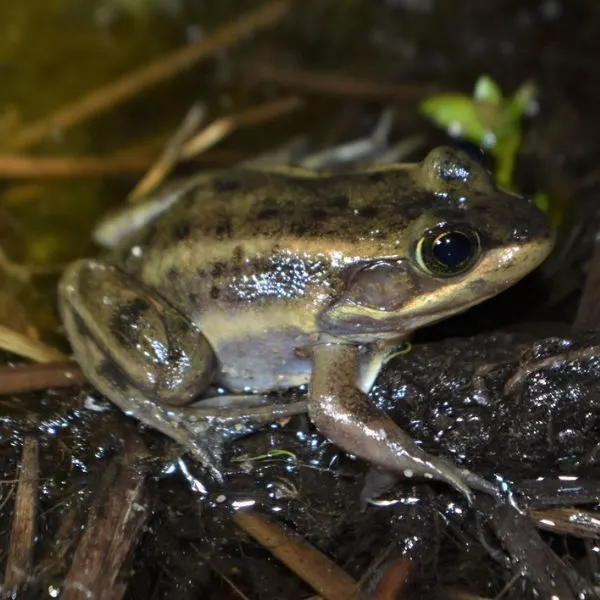
- Experience Level: Intermediate to Advanced
- Family: Ranidae
- Scientific Name: Lithobates virgatipes
- Other Names: sphagnum frog
- Adult Size: 1.5 to 2.5 inches
- Lifespan: 3 to 6 years
- Average Price Range: N/A
Carpenter frogs are an aquatic species found in the southern half of New Jersey. They live in highly vegetated waters like ponds, marshes, and swamps.
They prefer waters with a higher level of acidity. From April to August this species will breed and lay its eggs on vegetation in ponds.
They have a healthy population but have been victims of habitat loss and pollution. In New Jersey, they are listed as a species of concern and are actively being protected.
Carpenter frogs are named after their mating call, which sounds like a carpenter’s hammers.
They are medium-sized species, usually brown in color. Their bellies are brown or white.
They have smooth moist skin, with four yellow stripes that run down their back. They have long feet with webbing but do not cover the tip of their longest toe.
This species is most active at night, hunting crayfish, insects, and spiders.
Water snakes are their most notorious predator. Carpenter frogs spend a majority of their time in the water, using the aquatic vegetation for protection.
13. Green Frog

- Experience Level: Beginner
- Family: Ranidae
- Scientific Name: Lithobates clamitans
- Other Names: NorthernGreen Frog
- Adult Size: 2.25 to 5 inches
- Lifespan: 16 to 20 years
- Average Price Range: $10
Green Frogs are found all across New Jersey. Shallow freshwater bodies of water are where this species can be found.
They will hang around the shores of water sources, and jump into them when threatened. They are active during the day, and at night in warmer temperatures.
Breeding for this species occurs from April to August and will occur in permanent bodies of water. During winter they may still stay active, but slow their movement, feeding, and activity levels.
Green frogs come in a variety of colors like green, brown, yellow, and olive. Ridges go from their eyes to their back. They have spots covering their sides and back.
Their bellies are white with a black mottled pattern. On the side of their head is a circular tympanum, which is larger in males.
Since they are aquatic they have webbed toes. Mink frogs are often confused for this species but are not found in New Jersey.
Slugs, snails, crayfish, flies, moths, small snakes, and frogs are what their diverse diet is made of.
They will sit and wait for prey to come by, then ambush them. Even with their large size, they are still preyed on by snakes, raccoons, otters, birds, and large frogs.
14. Wood Frog
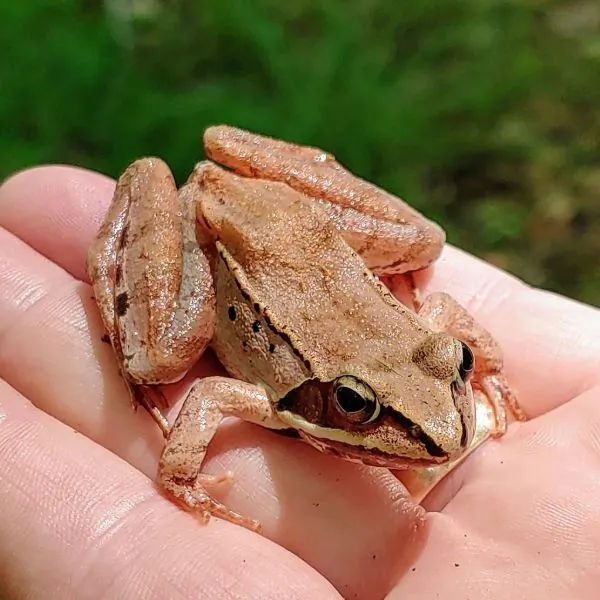
- Experience Level: Beginner
- Family: Ranidae
- Scientific Name: Lithobates sylvaticus
- Other Names: Rana sylvaticus
- Adult Size: 1.375 to 2.75 inches
- Lifespan: 1 to 3 years
- Average Price Range: $15 to $30
Wood Frogs can be found all over New Jersey, living in a variety of habitats near freshwater. Swamps, pools, and other freshwaters near woodlands are where they can be found in spring to breed, hibernating there also during winter.
Woodlands, forests, swamps, and ravines are places they will go during summer, only moving upland to hibernate during the winter.
Wood frogs are active during the day and not seen at night often. They are known for their cold resistance and are one of the first frogs to emerge after winter.
Small in size, wood frogs usually have a brown or tan color. They have a dark mask pattern over their eye. Their underside is pale with no markings.
Their color can vary, as they have the ability to change the shade of brown on their skin. Their brown coloring helps them blend into leaf litter and other natural debris.
Wood frogs eat small insects and other invertebrates found on the forest floor. The look of this frog is unique to itself, as no other frog looks similar to it in North America.
They also have the ability to freeze as survive. In winter their body will freeze and stop its heart. A special antifreeze is produced in the body to help keep them alive.
15. Atlantic Coast Leopard Frog

- Experience Level: Intermediate to Advanced
- Family: Ranidae
- Scientific Name: Lithobates kauffeldi
- Other Names: N/A
- Adult Size: 2 to 3.5 inches
- Lifespan: 2 to 5 years
- Average Price Range: N/A
Originally thought to be the southern leopard frog, the Atlantic Coast Leopard frog is a subspecies that can be found in New Jersey.
Living in areas like wetlands, marshes, meadows, and other slow-moving habitats, this species is widely distributed throughout the state. Open areas next to highly vegetated aquatic habitats are where they are most commonly found.
Olive green to mint gray is their base color, covered in dark brown leopard-like spots. A yellow line goes from its snout down into its back.
This species is very similar to the southern leopard frog and can be easily confused with the other leopard frog species. Atlantic coast leopard frogs have a more rounded snout and no white spot on their eardrum.
Their mating call is also different, making a single “chuck” sound. They are also able to change their color slightly depending on the habitat.
Ants, beetles, worms, and flies are just some of the things this species eats. They will feed on anything that can fit into their mouth, even eating smaller species of frogs, snakes, and birds.
This frog faces common predators other frogs face like birds and bullfrogs. They are a relatively new species, with plenty still being discovered about them.
16. Pickerel Frog

- Experience Level: Intermediate
- Family: Ranidae
- Scientific Name: Lithobates palustris
- Other Names: Rana palustris
- Adult Size: 1.75 to 3 inches
- Lifespan: 5 to 8 years
- Average Price Range: $10 to $15
Pickerel frogs can be found in habitats all over New Jersey. Near streams, rivers, marshes, and other freshwater habitats with high vegetation are areas they prefer to live.
Most commonly found in waters near the coastal plains, pickerel frogs will breed from March to May. They are nocturnal and will hibernate in the winter, burrowing themselves at the bottom of streams.
Pickerel frogs have smooth skin with tan coloring. They are covered in dark brown blotches down their back, sides, and legs.
Their bellies are pale with orange coloring on the inside of their hind legs. Two yellow dorsolateral folds run down their back.
The Leopard frog is often confused for this species but can be distinguished by the orange coloring between the pickerel frog’s legs. They are also able to produce a toxin on their skin that protects them from predators like snakes.
Spiders and small insects are the diets of this species. They are often seen near grassy areas around water to hunt.
This frog can be kept as a pet but is harder to keep when compared with other native species. Their toxin can irritate skin and is strong enough to kill smaller animals.
Wrapping up
New Jersey has 16 different species of frogs and toads living in the state, each an important part of the environment.
Habitat loss, pollution, and disease are some of the things that have caused many species to slowly lose population. Many frog species are on the path to endangerment, and learning about them can help protect and preserve each species.
Some of the frogs and toads on this list can also make great pets such as the gray tree frog or leopard frog. When looking to get a frog as a pet you should do your research, as each species has its own needs and care level.
All the frogs in New Jersey are valuable in helping control the pest population and are a food source for different predatory species. They help bring balance to the environment and can be a joy to watch in nature.
Hopefully, this is helpful for the next time you want to learn about different species, or come across a frog in nature.
Nearby states
